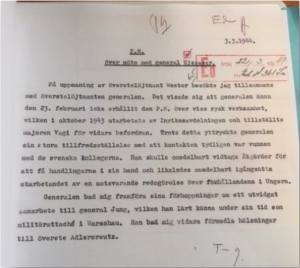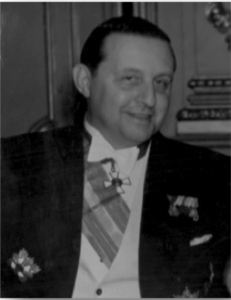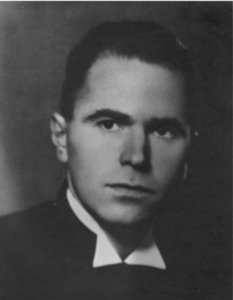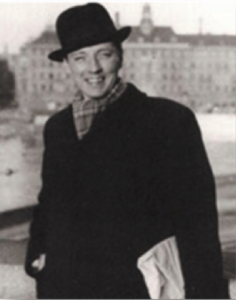13.02.2019
Swedish intelligence documents raise new questions about the fate of Raoul Wallenberg
Secrets kept for 75 years
The documentation shows that in 1943, Sweden and Hungary entered into a secret intelligence sharing agreement about Soviet espionage operations. The information has potentially important ramifications for the search for the young Swede who saved thousands of Hungarian Jews during the Holocaust and who disappeared in the Soviet Union in 1945.
On the request of the authors and members of Raoul Wallenberg’s family, last July the Swedish Military Intelligence and Security Service (MUST) released three documents that have remained classified for 75 years.[1] The new documentation shows that in October 1943, Swedish intelligence officers entered into a secret intelligence sharing agreement with high-ranking members of the Hungarian military – and counterintelligence organizations, regarding Communist and Soviet espionage operations. Among other things, the Swedish Defense Staff compiled a secret report about Soviet intelligence networks in Sweden that it shared with its Hungarian counterparts. In return, Swedish intelligence officials received sensitive information about Communist underground activities in Hungary. Only the Hungarian report has been publicly disclosed and it is unclear if the Swedish report has been preserved.
The Swedish action occurred in direct response to a personal request made as early as April 1943 by Maj. General István Ujszászi, head of the Hungarian State Security Center (Államvédelmi Központ) that coordinated military and civilian defense activities in Hungary.
The agreement was discussed and approved at the highest levels of the Swedish Defense Staff. Ujszászi and Lt. Col. Harry Wester, the Swedish Military Attaché in Budapest, met on a regular basis. On at least one occasion, Captain Helmuth Ternberg, Deputy Head of C-byrån (C-Bureau, a highly secret Swedish intelligence agency under the Swedish Defense Staff during WWII), joined Wester in a meeting with Ujszászi in early 1944, to discuss the implementation of the secret intelligence exchange.[2]
Why does any of this matter, 75 years after the fact?
The previously unknown contacts indicate that the agreement was part of a more expanded focus of Swedish intelligence operations regarding the Soviet Union that began in 1943 and extended beyond the traditional areas of Finland and the Baltic states, to Eastern and Central Europe and the Balkans. Swedish involvement in such activities was especially sensitive because since June 28, 1941, Sweden officially represented Soviet interests in Hungary and other Axis countries. This is almost certainly one of the reasons why the documentation has remained secret until now. Also, by 1943, members of the Swedish Defense Staff started a more willing and expanded cooperation with U.S. and British intelligence representatives that had lagged behind the traditionally close exchange with German officials.
The new documentation is especially valuable because nearly all information regarding the Swedish Defense Staff’s clandestine activities in Hungary seemed to have completely vanished from Swedish archives. The material is believed to have been intentionally destroyed after WWII, but many analysts doubt that all information has disappeared. The new documentation released from the MUST is a strong indication that at least some information has survived and remains to be discovered in Swedish intelligence collections, as well as other international archives.

Memorandum received by the Home Affairs Department of the Swedish Defense Staff in March 1944, outlining discussions regarding a secret Swedish-Hungarian intelligence sharing agreement concerning Soviet espionage operations in Sweden and Hungary. Source: Swedish Military Intelligence Archive (MUST), Stockholm
The new information is of interest also because in early 1945, Maj. Gen. Ujszászi was detained by the Soviet NKVD troops and transferred to the POW Camp no. 27 near Moscow. Part of his testimonies about the joint preparation of Hungary and Nazi Germany for the war against the Soviet Union were presented at the International Military Tribunal in Nuremberg. After that, he was questioned by Soviet interrogators in detail about the different attempts by the government of Miklós Kállay – Hungary’s Prime Minister from March 1942 until March 1944 – to establish contact with the Western Allies. In August 1948, on request by the Hungarian State Security (ÁVO), Ujszászi was sent back to Hungary. The published record of his interrogations shows that he was asked by ÁVO investigators specifically about his wartime contacts with the Swedish military attaché Harry Wester.[3]
The joint Swedish-Hungarian intelligence agreement ended almost immediately with the German occupation of Hungary on March 19, 1944. However, the noticeable shift in focus of Swedish intelligence operations in 1943 adds an important new dimension to the secret Swedish cooperation with the Anglo-American Allies in Sweden and Hungary during the years 1943-1945 and the simultaneous efforts by Hungarian government officials to extricate their country from hostilities in World War II. The Soviet leadership was extremely suspicious of the Hungarian efforts to establish a “separate peace” with the Western Allies, fearing it would eventually lead the defeated Axis powers to join Anglo-American forces in a one-front war against the Soviet Union. All this raises important additional questions about the background of Raoul Wallenberg’s humanitarian mission to Budapest in July 1944 to assist Hungary’s Jews, his possible connection to Swedish and Allied intelligence operations, as well as the official Swedish handling of Wallenberg’s disappearance in 1945 and subsequent years.
The timing of the secret Swedish-Hungarian intelligence sharing arrangement in the autumn of 1943, nine months before Raoul Wallenberg’s appointment as a Swedish diplomat in July 1944, is potentially significant. So are the individuals involved in these discussions. The new documentation suggests that systematic preparations by U.S. and Swedish intelligence representatives to collect information from Hungary, as well as to provide active support to the Hungarian resistance, started in earnest already in late October 1943, and not only in the spring and summer of 1944, as previously thought. The aim of these efforts – which also involved important Hungarian contacts in Stockholm – was to explore the feasibility of a planned Anglo-American military intervention in Hungary, to bring about the defeat of Nazi Germany, and, at the same time, to prepare for the expected Soviet occupation of the country.

Dr. Antal Ullein-Reviczky, the Hungarian Minister in Stockholm 1943-1945. Source: The Antal Ullein-Reviczky Foundation, Hungary
Previous investigations have found no indication that Wallenberg had any formal ties to Swedish or Allied intelligence operations. However, the newly released information shows that an important part of the communications between Swedish and Hungarian intelligence operatives was carried out via the Hungarian Legation in Stockholm. The broader Swedish and Allied cooperation also directly and indirectly involved individuals with whom Wallenberg had personal contact at the time in Sweden. These were most notably Dr. Antal Ullein-Reviczky, the Hungarian Minister who knew Raoul Wallenberg since September 1943 and who attended his farewell dinner before Wallenberg’s departure for Budapest in July 1944; Robert Taylor Cole, head of the U.S. Office of Strategic Services’ (OSS) Secret Intelligence (SI) branch in Stockholm; and possibly also Captain Helmuth Ternberg (whose brother, the Swedish Navy Officer Egon Ternberg, was one of Raoul Wallenberg’s godfathers). Later, in Hungary, they included Lt. Thorsten Akrell, a special agent of the Swedish Defense Staff; Lt. Col. Harry Wester, the Swedish Military Attaché in Budapest; and Dr. Géza Soós, one of the leaders of the Magyar Függetlenségi Mozgalom (MFM, the Hungarian Independence Movement), Hungary’s main resistance group. After the war, R. Taylor Cole emphasized in his memoir that, “our Hungarian interests and contacts occasioned a meeting with Raoul Wallenberg”, shortly before his departure for Budapest, suggesting that Wallenberg’s mission possibly also involved aspects that went beyond purely humanitarian aims.[4]
In the process of analyzing the newly released documentation, several additional details emerged regarding Swedish intelligence operations in Hungary in 1943-1945 that are also of interest to the Raoul Wallenberg investigation. These new details are especially interesting when placed in context with previously known facts.
The documentation released from American National Archive in the early 1990s shows that the Swedish C-Bureau – in close cooperation with U.S. intelligence representatives in Stockholm – tried to support the Hungarian resistance by creating a secret “signal plan” that was to be used during a planned revolt against the German occupiers. Géza Soós, one of the leaders of the MFM, had a central role in these plans. He also had direct contact with both Raoul Wallenberg and Per Anger, First Secretary at the Swedish Legation in Budapest who provided Swedish protective documents before Wallenberg’s arrival.
Already in 2000, the Swedish intelligence archivist Göran Rydeberg suggested that several (possibly as many as five) Swedish signal intelligence officers were deployed to Hungary beginning in late 1943. British intelligence historian Craig McKay has recently identified one of these officers as Nils ”Nisse” Johansson, who apparently was loaned out to the Swedish Defense Staff from his regular employer, the Swedish National Defense Radio Establishment (FRA).[5] According to McKay, “Nisse” Johansson and his colleagues may have provided the necessary technical assistance to Soós and his colleagues in the autumn of 1944. None of the communications sent and received by Swedish signal intelligence personnel deployed to Budapest has been released from Swedish archives. Johansson’s assignment and work in Hungary has never been formally acknowledged by Swedish authorities.

Dr. Géza Soós, co-founder of the MFM, the main resistance movement in Hungary; Source: Wikipedia
The presence of Swedish signal intelligence officers in Budapest suggests that the members of the Swedish Legation, including Raoul Wallenberg, had available to them an additional channel of secret communications with Stockholm. The new insights also lend added credence to previously reported claims that members of the Hungarian resistance relayed key information about potential bombing targets to Allied forces located in Bari (Italy) and Malta via a transmitter in the Swedish Legation. This information was first outlined by the Swedish historian Gellar Kovacs in 2013.[6]
The newly released information also raises additional questions about Per Anger’s contacts with the Hungarian resistance. On October 23 and 25, 1944, Anger, acting in his official capacity as a Swedish diplomat, forwarded two communications on behalf of Géza Soós and the MFM to Soviet authorities.[7] No trace of these two messages the MFM wished to relay to Soviet officials has been located in Swedish archives. Anger almost certainly did not transmit these communications directly to the Soviet Union but probably sent them to the Swedish Ministry of Foreign Affairs in Stockholm, for forwarding to Moscow. If so, a copy of these messages should be available in the Swedish Foreign Ministry’s central archive. It is known that the Soviets received and answered the messages. This means that records should also exist in Russian archival collections, including those of the Soviet Embassy in Stockholm. This documentation could provide helpful leads to additional information regarding the activities of the Swedish Legation personnel, including Raoul Wallenberg, in Hungary and how the Soviet political leadership may have assessed these contacts.

Per Anger, First Secretary at the Swedish Legation, Budapest in 1944
It has never been fully disclosed what exactly Raoul Wallenberg’s colleagues told Soviet officials, when they themselves were detained by Soviet NKVD troops in early 1945 in Hungary, and later, to their Swedish superiors. If either the members of the Swedish Legation or Raoul Wallenberg were actively involved in assisting the Hungarian resistance and other Swedish-Allied intelligence projects in Budapest in 1944, it would offer a possible additional explanation why Swedish officials decided to reveal as little as possible about these activities once Wallenberg disappeared.
Raoul Wallenberg’s humanitarian mission and his selection for this mission must now be placed in the context of this more complex reality. Specifically, it must be examined further to what degree Swedish officials were aware of these complexities and may have feared exposure of the extensive secret cooperation between Swedish and Anglo-American intelligence 1943-1945, to some extent against Soviet interests. This cooperation was clearly expected to continue in the post-war era and might have influenced the official Swedish handling of Raoul Wallenberg’s disappearance after January 1945. A central question remains why the new information has been publicly disclosed only now, more than seven decades later. Requests by researchers on behalf of Raoul Wallenberg’s family that were submitted almost a year ago, in March 2018, to review pertinent records in the archives of the Swedish Ministry of Foreign Affairs and the Wallenberg Family Archive (Stiftelsen för Ekonomisk Historisk Forskning inom Bank och Företagande, SEHFBF) have so far not received a positive reply.[8] Swedish Foreign Ministry officials have indicated that they are reviewing up to one shelf meter of still classified documentation for release.
It is time for Swedish officials to provide long overdue answers to the important open questions remaining in the Raoul Wallenberg case and that they grant full access to the documentation that is urgently needed to finally establish the full circumstances of Wallenberg’s fate in Russia.
Raoul G. Wallenberg
Raoul G. Wallenberg (1912-1947?) was a Swedish diplomat and businessman. At the end of WWII, Wallenberg showed extraordinary courage when he embarked on a humanitarian mission – initiated and funded in large part by the U.S. War Refugee Board – to protect the remaining Jewish communities in Hungary from Nazi persecution. During six harrowing months in 1944, Wallenberg and his colleagues managed to protect thousands of Budapest’s Jews from deportation and certain death. In January 1945 Wallenberg was detained by the Soviet military counterintelligence and taken to Moscow where he disappeared. Soviet and later Russian authorities have claimed that Wallenberg died suddenly in a Moscow prison on July 17, 1947, as a result of a heart attack. The information has never been confirmed.
About the Authors
Susanne Berger is a historical researcher and journalist. She served as an independent consultant to an official Swedish-Russian Working Group that investigated Raoul Wallenberg’s fate from 1995-2001. She is the founder and coordinator of the Raoul Wallenberg Research Initiative (RWI-70). Founded in 2015, the RWI-70 is an informal alliance of more than 80 international historians, Holocaust survivors, family members of former political prisoners, legal experts and human rights defenders, all of whom pool their expertise in an effort to obtain full clarity about Wallenberg’s fate after he disappeared in the Soviet Union in 1945.
Dr. Vadim Birstein, a biologist and historian, was a member of the first International Commission on Raoul Wallenberg headed by Prof. Guy von Dardel, Wallenberg’s half-brother, in 1990-91. He has published numerous articles on the Wallenberg case (some co-authored with Susanne Berger) and is the author of the books “The Perversion of Knowledge: The True History of Soviet Science” (2001) and “SMERSH, Stalin’s Secret Weapon: Soviet Military counterintelligence in WWII” (2012), which received the inaugural St. Ermin’s Intelligence Book Award in 2012.
Contact: info@fritz-bauer-blog.de






